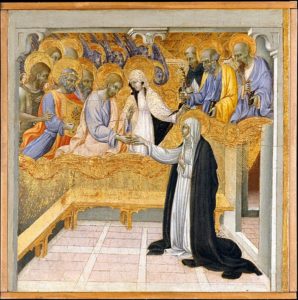Or:
How the Woke monster originated
Giovanni di Paolo, The Mystic
Marriage of St Catherine of Siena.
On one occasion, when Christ appeared to Catherine of Siena, he did so accompanied by Mary Magdalene. Catherine, weeping with an excess of love, remembered how Mary, kneeling before the feet of her Lord, had once wet his feet with her own tears, and then wiped them with her hair, and kissed them, and anointed them with perfume. ‘Sweetest daughter,’ Christ told her, ‘for your comfort I give you Mary Magdalene for your mother.’ Gratefully, Catherine accepted the offer. ‘And from that moment on,’ so her confessor reported, ‘she felt entirely at one with the Magdalene.’
To be paired with the woman who had first beheld the risen Christ was, of course, a rare mark of divine favour. From childhood, Catherine had taken the Magdalene as a particular role model. Far from betraying complacency, though, this had borne witness to the opposite: Catherine’s own gnawing sense of sin. As reported by Luke, the woman who wept before Jesus, and anointed his feet, had ‘lived a sinful life’. Although she was never named, the identification of her with the Magdalene was one that had enjoyed wide currency ever since Gregory the Great, back in 591, had first made it in a sermon. Over time—and despite the lack of any actual evidence for it in the gospels—the precise character of her ‘sinful life’ had become part of the fabric of common knowledge. Kneeling before Jesus, seeking his forgiveness, she had done so as a penitent whore. Catherine, by accepting the Magdalene as her mother, was embracing the full startling radicalism of a warning given by Christ: that prostitutes would enter the kingdom of God before priests. [pages 285-286]
My book Daybreak (pages 132-135) contains an article with a splendid quote from Umberto Eco’s novel The Name of the Rose, where a wise Franciscan tells his pupil that the radicalism of St Francis was about empowering all sorts of ‘lepers’—the radical message of the gospel—as opposed to giving them simple alms. Those who haven’t read that article, which I entitled ‘On empowering carcass-eating birds’, should read it now. Using an article of The Occidental Observer it illuminates our understanding of how, in the secular phase of Christianity, the metastasis of gospel ethics has reached our day with the transgender movement: the new ‘leper’ to be empowered just as prostitutes would enter the Kingdom before priests! However, Christians, even medieval Christians, have always been contradicting themselves. Tom Holland continues:
In Paris, as the great cathedral of Notre Dame was being built, the offer from a collective of prostitutes to pay for one of its windows, and dedicate it to the Virgin, had been rejected by a committee of the university’s leading theologians. Two decades later, in 1213, one of the same scholars, following his appointment as papal legate, had ordered that all woman convicted of prostitution be expelled from the city—just as though they were lepers…
Yet always, lurking at the back of even the sternest preacher’s mind, was the example of Christ himself. In John’s gospel, it was recorded that a woman taken in adultery had been brought before him by the Pharisees. Looking to trap him, they had asked if, in accordance with the Law of Moses, she should be stoned. Jesus had responded by bending down and writing in the dust with his finger; but then, when the Pharisees persisted in questioning him, he had straightened up again. ‘If any of you is without sin, let him be the first to throw a stone at her.’ The crowd, shamed by these words, had hesitated—and then melted away. Finally, only the woman had been left. ‘Has no one condemned you?’ Jesus had asked. ‘No one, Sir,’ she had answered. ‘Then neither do I condemn you. Go now and leave your life of sin.’ [pages 286-287]
In the video I embedded on Thursday St Francis, dressed in rags, in front of the pope on his throne with the cardinals, bishops and abbots of the papal court, recites some of the words of Jesus in the Sermon on the Mount praising ultimate poverty as a protest that the teachings of Christ are totally opposed to Rome’s obsession with wealth. The struggle between the purist monks that follow the gospel message and the more practical Roman curia has always existed. But it is something the American racial right is unwilling to acknowledge: obsessed as they are with blaming only contemporary Jewry for the subversion of the Church when the revolutionary message of the last being first came directly from the New Testament—a NT written by Jews!
Innocent III, that most formidable of heresy’s foes, never forgot that his Saviour had kept company with the lowest of the low: tax-collectors and whores. Endowing a hospital in Rome, he specified that it offer a refuge to sex-workers from walking the streets. To marry one, he preached, was a work of the sublimest piety… Prostitutes themselves, perfectly aware of the example offered them by the Magdalene, veered between tearful displays of repentance and the conviction that God loved them just as much as any other sinner. Catherine, certainly, whenever she met with a sex-worker, would never fail to assure her of Christ’s mercy. ‘Turn to the Virgin. She will lead you straight into the presence of her son.’

One reply on “Dominion, 15”
It might be fanciful conjecture on my part, but the current Western ban on prostitution could be viewed as setting their priorities straight – while both sacrosanct, cucking men is definitely higher on the list than female rights.